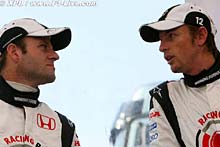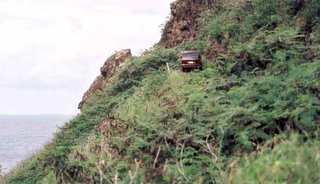Ever since Roger Moore's debut in Live and Let Die, Bond fans have debated furiously. The topic: Who is the best Bond? With Daniel Craig's Casino Royale premiering next month, the debate is sure to get more heated.
I have always thought of Moore as the best and the rest as not good enough. However, I have never sat down and considered each actor's flaws and attributes. So here, after much pondering, and after watching a lot of Bond films (16 in 45 days), is my list.
Not ranked. George Lazenby
5. Daniel Craig
4. Sean Connery
3. Pierce Brosnan
2. Timothy Dalton
1. Roger Moore
The unrankable. George Lazenby. Just as you can't judge a batter with one at-bat, you can't judge Lazenby based on just one movie. After all, would it be fair to judge Connery based on just Never Say Never Again, or Moore based on just Moonraker? Because Lazenby, the Australian model extraordinaire, starred in only one movie and was quickly replaced by his predecessor, a stigma, no, a stench, was attached to OHMSS and its star. This snowballed into basic cable networks benching OHMSS during (insert your holiday) Bond movie marathons as if it were Pee Wee Herman in the Yankee's line-up. This in turn led Bond-philes to conclude that Lazenby was a shitty Bond.
But if one set aside biases and preconceived notions, sat down, and tried to enjoy OHMSS, the inevitable conclusion is that Lazenby was pretty darn good. He had a sense of humor ("This never happened to the other guy", after a woman ran away from him). He had a playful penchant for beautiful girls (he swiped a Playboy magazine page from a Swiss lawyer's office). He had heart (the last scene when Mrs. Bond died). Lazenby had the potential to be a great Bond. Too bad we'll never know.
The ass. Daniel Craig. I must admit that I've never heard of Craig before he was cast as Bond. But he's got two things going against him. One. He's blond. Two. He does not know how to drive a stick shift. I will go into Casino Royale with an open mind, but it does not look good for Mr. Craig.
The classic Bond. Sean Connery. Purists are already gathering at the town square, torches and pitchforks in hand. How dare he rate THE quintessential and ONLY TRUE Bond, fourth? Well, I like the guy. But it's a generation thing. I was born in the 70s. Connery is the baby boomers' Bond. He's suave and never takes himself too seriously. He's macho, yet sophisticated. He's a pretty good actor. But he's just too old fashioned. My apologies.
The pretty boy Bond. Pierce Brosnan. Upon reflection, none of Brosnan's movies are on my top ten list. So what makes him so fun to watch? It's his enthusiasm. His
joy de vivre. One brief scene captures this. In Tomorrow Never Dies, Brosnan is controlling his BMW 750iL in the back seat with an Erickson mobile phone. The childlike joy on his face says it all. He loves being James Bond.
The much maligned Bond. Timothy Dalton. Like Lazenby, Dalton is unfairly disliked due to the handicap of not starring in enough films. His performance in The Living Daylights, on its own, should catapult him to the top (or close to the top) of the list. He is a serious and extremely skilled actor. He captured 007's id, ego, and superego fully and flawlessly. Even in License to Kill, he was able to make the best out of the situation, given the contemporary AIDS epidemic, Priscilla Barnes (of Three's Company fame) as Mrs. Leiter, a shitty script, an uninspired villain, and a Lincoln Continental Mark VII as his vehicle.
The Bond of my childhood. Roger Moore. His character is cartoonish. He is not a great actor. He's older than Connery. But he's still the best, in my eyes. Most Bond fans saw their first film in the theater. Growing up, I had little adult supervision and access to pay cable. In addition to watching psychosis- inducing thrillers such as Poltergeist, I also got to see many of Moore's works at home after elementary school. The Spy Who Loved Me and For Your Eyes Only are at or near the top of my list of all time greatest Bond films not only because they are entertaining, but also because those were the first movies I saw.
CKY
 If I were a betting man, I would wager that at least one or two Rat Packers had one of these puppies. A detuned racing engine was stuffed under the bonnet. The 4.1 liter V8 used all 256 horses to achieve an incredible 143 mile per hour top speed. Moreover, the styling equalled the awe-inspiring performance.
If I were a betting man, I would wager that at least one or two Rat Packers had one of these puppies. A detuned racing engine was stuffed under the bonnet. The 4.1 liter V8 used all 256 horses to achieve an incredible 143 mile per hour top speed. Moreover, the styling equalled the awe-inspiring performance. Only 13 of these were ever made. It shared many components with the Citroen SM, including the chassis, the hydropneumatic suspension, FWD set-up, and swivelling headlights. An asthmatic Merak V6 producing less than 200 horsepower was used. To put it simply: It just ain't right.
Only 13 of these were ever made. It shared many components with the Citroen SM, including the chassis, the hydropneumatic suspension, FWD set-up, and swivelling headlights. An asthmatic Merak V6 producing less than 200 horsepower was used. To put it simply: It just ain't right. For most, this is the Quattroporte that comes to mind. It was meant to compete with the Benz 450SEL 6.9 (of recent Ronin fame). The controversial styling was a favorite among Italian magnates. If anything, it definitely stood out in the crowd.
For most, this is the Quattroporte that comes to mind. It was meant to compete with the Benz 450SEL 6.9 (of recent Ronin fame). The controversial styling was a favorite among Italian magnates. If anything, it definitely stood out in the crowd. Though I am a pretty big car nut, this version of the fourdoor flew completely under the radar. I did not learn of it until very recently. Though it performed well on the road (it has a 158 mph top speed when coupled with the 330 hp V8), it looks like an anonymous Japanese sedan. Too much emphasis was placed on aerodynamics. No effort was made to connect it with its northern Italian roots.
Though I am a pretty big car nut, this version of the fourdoor flew completely under the radar. I did not learn of it until very recently. Though it performed well on the road (it has a 158 mph top speed when coupled with the 330 hp V8), it looks like an anonymous Japanese sedan. Too much emphasis was placed on aerodynamics. No effort was made to connect it with its northern Italian roots. Aside from the jerky transmission, this sedan is perfect. When I saw Vincent Chase's Entourage ride in one, it was perfect. With a 400 horsepower Ferrari engine capable of reaching 60 in 5 seconds flat, this car not only looks fast. It is fast.
Aside from the jerky transmission, this sedan is perfect. When I saw Vincent Chase's Entourage ride in one, it was perfect. With a 400 horsepower Ferrari engine capable of reaching 60 in 5 seconds flat, this car not only looks fast. It is fast.




















































